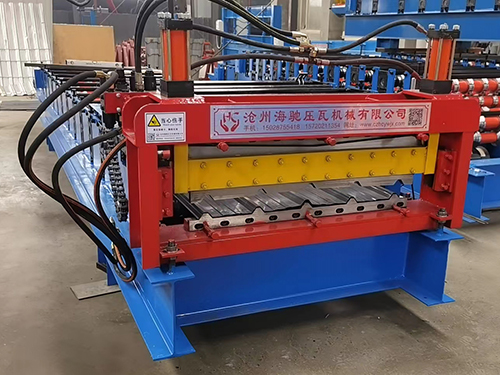-
Single layer tile press series
-
Double layer tile press series
-
Three layer tile press series
-
Floor bearing plate equipment
-
Glazed tile equipment series
-
Jiaochi equipment series
-
C/z/u-shaped steel forming mac
-
Carriage plate forming machine
-
Anti skid embossing equipment
-
Aluminum magnesium manganese 4
-
Ridge tile forming machine ser
-
Light steel keel machine serie
-
Shearing machine bending machi
-
Rock wool foam integrated sand
-
Rolling shutter door equipment
-
Discharge rack series of hydra
-
Export equipment series
-
Kaiping machine series
-
pipe benders
-
Customize cold bending equipme

840 flat plate (pressed stainless steel)

840 flat plate (stainless steel) double-layer tile press technical parameters:
1. Overall dimension of equipment installation: 6200mm × 1300mm × 1000mm
2. Total weight of equipment: about 4000kg
3. Host power: 3kw
4. Hydraulic shear power: 3kw
5. Hydraulic station pressure: 10-12mpa
6. Scale: 840 type 23mm; 900 type 15mm pitch: 840 type 210mm; 900 type 225mm
7. Electric control system: the whole machine is controlled by industrial computer PLC
8. Working speed: 0-8m/min
9. The tile pressing machine can bear galvanized sheet or color steel plate less than 1mm
840 flat plate (pressed stainless steel) double-layer tile pressing machine is composed of feeding, forming and post forming cutting. Its components include: the whole machine, PLC computer control system, hydraulic pump station system, and full-automatic post shearing system
840 flat plate (stainless steel) double-layer tile press adopts high-quality automatic control software to realize production information management. The automatic control system of the whole unit adopts highly integrated network, which makes the automatic system have good performance
840- the products produced by the flat plate (stainless steel) double-layer tile press have flat and beautiful appearance, uniform paint lines, good strength and excellent quality. They are widely used in industrial and civil buildings, such as factory buildings, warehouses, locomotive hangars, aircraft hangars, gymnasiums, exhibition halls, cinemas and other rooms and walls
the installation of color plates produced by tile press is easy to master, and the treatment of some details is more important. For the roof slab, the color plate should be trimmed at the roof and eaves, in order to effectively prevent rainwater from entering the roof. At the ridge of the roof outer plate, the chassis between the steel plate terminal ribs can be folded up with edge closing tools. It is used at the upper end of all roof steel plates with a slope lower than 1/2 (250) to ensure that the water blown in by the wind under the flashing or cover plate will not flow into the building

